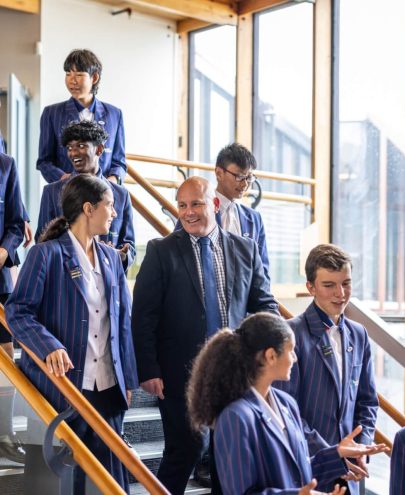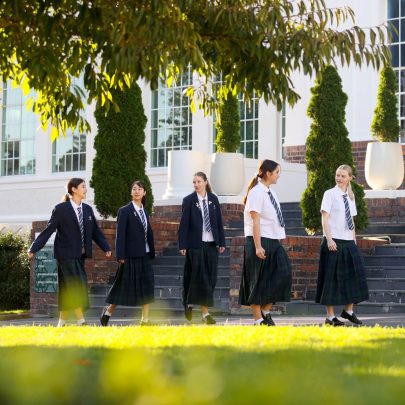Sep 17, 2014 Schools
There are some vastly different cultures among Auckland’s top-performing schools, but they all know what it takes to help pupils succeed. What are they doing right?
Published in Metro, July 2014. Photos by Simon Young.
He arrives at the doors of the Auckland Grammar School hall holding a bag of dried shiitake mushrooms, a camera phone and a tenuous grasp of English.
He’s popped in unannounced after the daily assembly, in the hope of grabbing a quick photo. His son’s name has just been added to the university scholarship honours board and while it’s preserved for posterity here, there’s nothing yet for the family album.
It takes him several minutes to find the right board, and the right name, among the thousands of duxes, head prefects and top scholars immortalised here. Finally, there it is — Zhang — one of two Zhangs and 42 Asian names on a board of 59 winners from 2013, a list that represents the changing face of not only Auckland, but its most famous school.
Nearly 150 years of Grammar history, tradition and, most important, pride is housed here in the assembly hall, where the gold leaf on these honours boards could buy a small island nation. Where a pastel portrait of Sir Edmund Hillary, the most famous old boy of all, stares ruggedly down on the current crop. And where 2540 boys are reminded each day of the Grammar Way — that they are here to pursue, and achieve, excellence.
If there is a secret to Grammar’s success, says headmaster Tim O’Connor, it is this, the daily assembly. “It is at the heart of how Grammar operates. It is essential. It is where we set the tone, it is where we celebrate success. That’s where aspirations are created every day.”
It is June 13, the day before the long-anticipated 1st XV rugby match with old foes King’s — their 202nd clash in 118 years. Hundreds of boarders crowd on to the carpeted stage for the haka, composed by old boy Sir Hugh Kawharu, which will open the game tomorrow. O’Connor then spells out the behaviour he expects from his boys on the sidelines. “It’s about a game of rugby and we shouldn’t get that out of perspective,” he says, before drawing an analogy with how the country feels when the All Blacks lose. No pressure, then.
Grammar’s tradition of academic and sporting prowess is reinforced at each assembly when the sports results and details of upcoming games are read, before any other notices and immediately after the school prayer. Today, though, there is also a celebration of musicianship as the school’s Glinka Group — introduced as Hu, Chuk, Wang, Zhang, Jin and Chang — perform their entry in the National Chamber Music Competition. They are astoundingly accomplished.
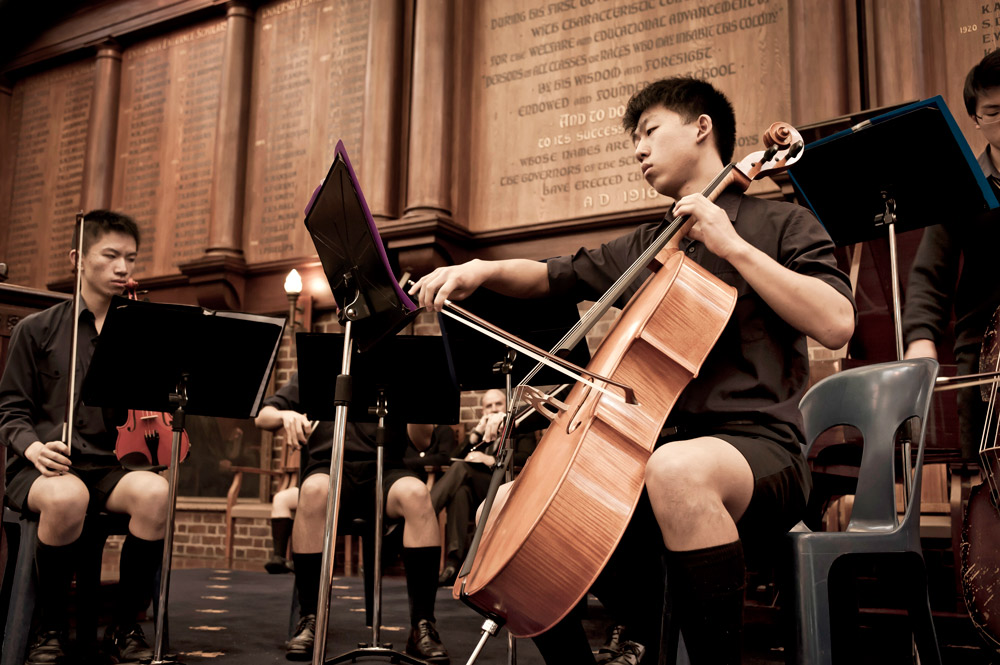
Each week, a handful of students with the most notable achievements will “cross the stage” to receive their award. Annually, the greatest applause — and the biggest cup — is reserved for the dux.
Winners raise their cup and the applause rises with it. “It’s phenomenal,” says O’Connor, who uses that word many times when talking about Grammar. “It is entirely cued by the students. It is something I haven’t seen anywhere in my teaching career. One of the really unique things about Grammar is that pride in the collective. The success of one of a group is the success of all.”
It’s a warmer place now, he says, than it was when a 16-year-old Hillary was infamously bullied by the school PE teacher in the 1930s. Hillary later wrote: “He cast his eye over my scrawny physique, rolled his eyes to the heavens, and muttered: ‘What will they send me next?’ He placed me in the misfit class with the other physical freaks. I developed a feeling of inferiority about my physique which has remained with me to this day, not about what [it] could achieve but a solid conviction about how appalling I looked.”
Against that, though, is the recognition that a Grammar school trip to Mt Ruapehu at the same age sparked his enduring passion for mountaineering.
These days, students like Hillary — who travelled in from Tuakau — wouldn’t get in to Grammar, which is at capacity. Any increase in roll size would mean the student body could not fit in the hall for daily assembly and the special character of Grammar, says O’Connor, relies on this gathering. “It is non-negotiable.”
Just over a quarter of current students moved into the Grammar zone six months or less before enrolling. “If the government is genuine in saying the concept of the zones is for schools to provide for their community, then the system is failing Auckland. We want a system to cap the number.”
O’Connor welcomes the burgeoning ethnic diversity in his school and acknowledges the high ratio of Asian performers in its top streams, “not because they’re naturally gifted, but because they’re prepared to work harder”. He says their work ethic has a trickle-down effect. “Wherever the bar is, boys rise to it.” Might it also make others give up? “It may. But that’s not the Grammar Way.”
With the demand on a place at Grammar at a premium, it means students — or their parents — willingly “buy in” to the Grammar culture. If you don’t want to be part of the unapologetically old-fashioned way — a strict uniform code, classes streamed according to academic ability, and a relentless exam schedule — well, quite frankly, you can bugger off.
O’Connor brought a similar approach to Palmerston North Boys High School, where he was rector for 10 years before moving to Grammar in 2012. Rebellious students and complaining parents would be shown the door. “We just say, ‘Get stuffed,’” he told North & South in 2007. “It’s as easy as that. Rules are rules and when you come here you sign up to those rules.”
But despite the similarities in the rules and the emphasis in both schools on celebrating success, he says Palmerston North, while a top performer, never captured the essence of what it means to “cross the stage” in an assembly at Grammar. Maybe the bar is higher here. Or perhaps the spirit of the 100-year-old hall itself works its own particular magic.
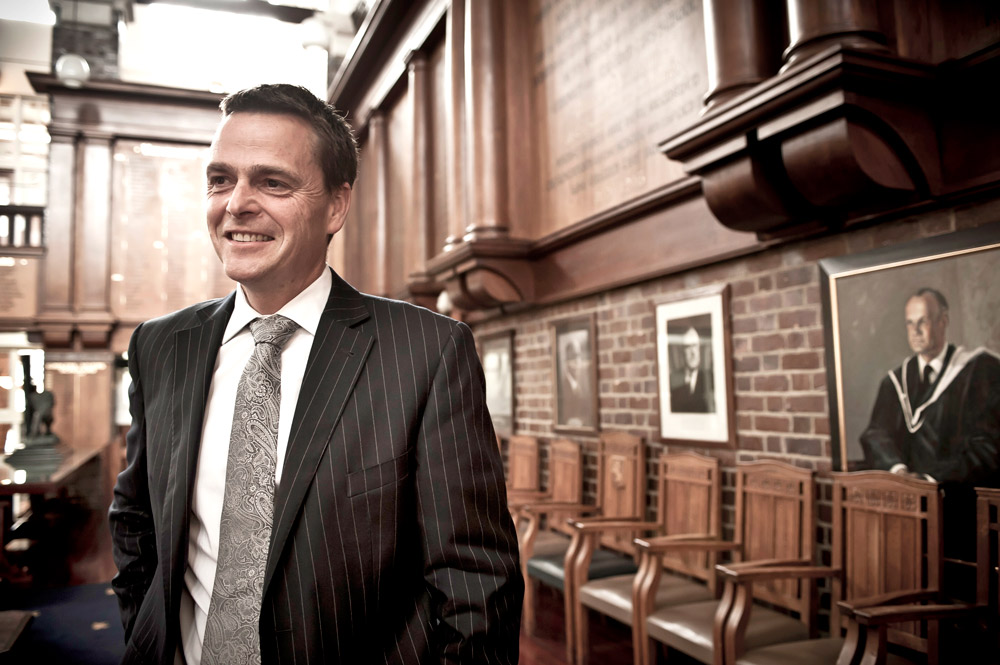
What makes a school successful, says education researcher Professor John Hattie, has little to do with structure, class sizes or even the attributes of its students, and more to do with understanding clearly what pupils know, and showing them at the start what success looks like. Think Angry Birds, he says.
“Angry Birds knows exactly what your prior achievement is — your last score. It then sets a target, a goal, success, using the Goldilocks principle — not too hard, not too easy.” It then piles in the feedback and gives you multiple tries to achieve the goal before increasing the standard. “You want to reinvest. It’s no different in our schooling. The critical difference is so often in schools, the students don’t know what success looks like.”
Metro examined four secondary schools this year: Auckland Grammar, Mt Roskill Grammar, Baradene College and St Cuthbert’s College — a state boys school, a state co-ed school, a Catholic girls’ school and a private girls’ school, all with different cultures, structures and styles.
But, in other areas, including several that Hattie’s research says really counts, they are strikingly aligned. They all have extensive early testing of student capabilities so they know precisely where a pupil is at on the first day of high school. They constantly measure teacher impact and student achievement. They seek, value and act on student feedback. They have a strong and identifiable culture. And they have teachers who understand that emotional wellbeing and educational achievement are inextricably linked, and can change their teaching styles accordingly.
At Mt Roskill Grammar, for example, a smart young soccer coach and English teacher, Callum Christopher, has found a novel way to leverage academic achievement off the back of his charges’ passion for football.
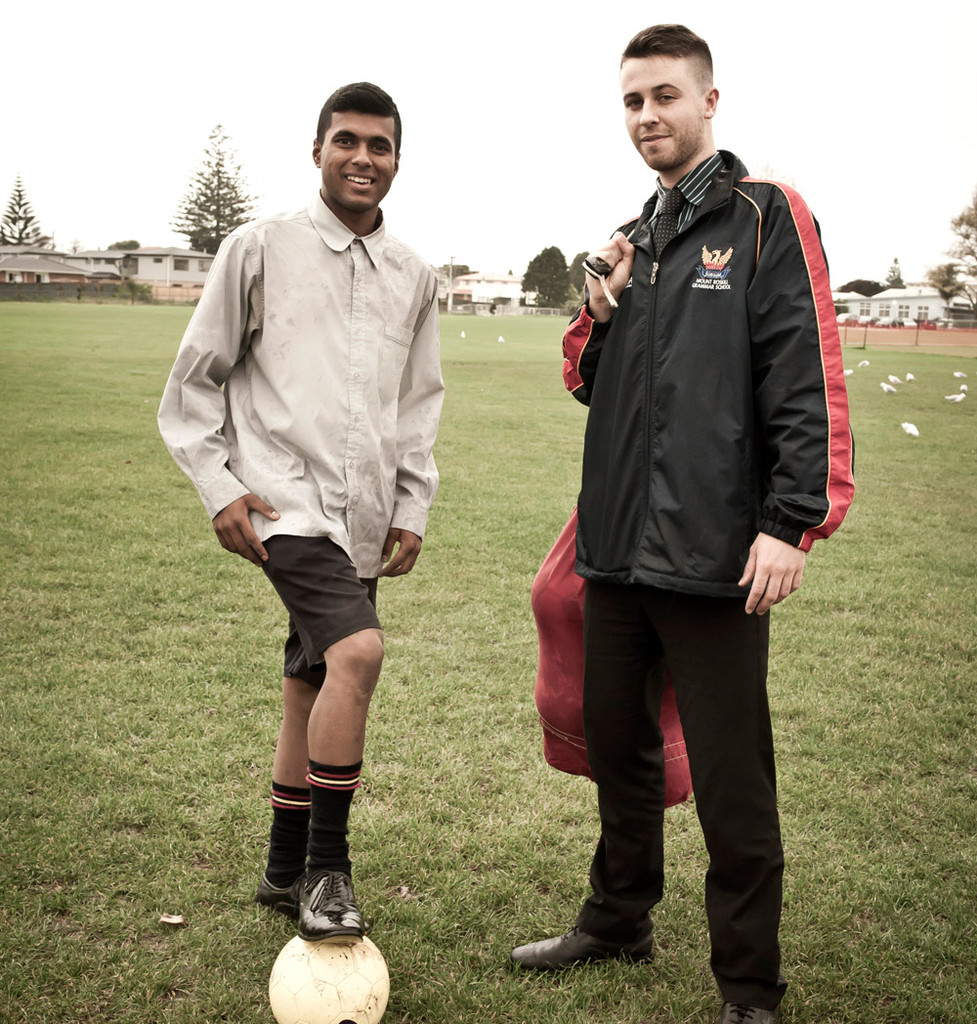
Santosh Singh (left) and coach Callum Christopher
Being Roskill is a video mini-series he’s produced for the past 18 months charting the progress of the school’s 1st XI. The movies are posted on YouTube and then used as the reading and writing study material for Year 9 and 10 boys in the school’s football academy.
Christopher, in only his third year of teaching, came up with the idea at the end of his first year at Roskill after seeing the University of Miami football team exploit the link between education and sport the same way. Junior boys watched the Being Roskill videos, writing essays about the characters and elevating 1st XI captain Santosh Singh to hero status. “You can’t ask a character from the American programme to walk in the door of the classroom — but when Santosh walked in the door, they were star-struck,” says Christopher.
He also runs a Being Roskill Facebook page where students comment on various aspects of the videos — but with a rule their postings have to be literate and with correct grammar, without the use of slang. “People think kids should get off Facebook, but we’re using social media to further basic academic skills.”
The school is now looking at ways to expand the concept into other areas, for example music. “If you’re passionate about something, it’s so much easier to influence people and get students to see the importance of education.”
As a decile 4 school with a diverse multicultural roll, including 30 per cent Indian and 24 per cent Pasifika pupils, a strong component of Roskill’s success has been its focus on student wellbeing, with students themselves driving the programmes. The school has 240 Peace Foundation-trained student mediators who handle low-level conflicts between pupils, and Year 9 students get two anti-harassment classes explaining how the school deals with bullying.
“In our school, the fear of narking has gone,” says guidance leader Margaret Hoogendoorn. Exclusions have more than halved in the past five years, to around seven or eight a year, a rate the school says is vastly better than other decile 4 schools, thanks to its student mediation and restorative justice programmes.
That’s similar to Auckland Grammar’s, where O’Connor says about five boys a year are expelled. Yes, there are detentions — an hour and a half after school where boys are forced to sit, doing nothing at all, and talking to no one, in the assembly hall. Boys are said to loathe them with a passion.
At the girls’ schools, exclusion rates are vanishingly small. Baradene principal Sandy Pasley says only one girl has been excluded in her three years at the college, and at St Cuthbert’s, there have been none since 2005. Even detentions are rare at Baradene, where discipline is guided by the “loving heart” philosophy of St Madeleine Sophie Barat, founder of the Society of the Sacred Heart, whose nuns opened Baradene.
At St Cuthbert’s, where a staggering 45 per cent of Year 13 students won university scholarships — more than twice the proportion of the next best school, Auckland Grammar, with 29 per cent — working out how to increase already stratospheric achievement year on year has been the sort of problem many schools could only dream of.
St Cuthbert’s long-time principal, Lynda Reid, says that after a strategic planning exercise two years ago to set the school’s direction for the next decade, St Cuthbert’s has now instituted a “personal learning approach”, which puts more emphasis on the students’ emotional wellbeing. “The research we did showed that students who felt supported, who had a range of trusted adults mentoring them, performed best.”
New, smaller, tutor groups of between 14 and 17 students and two extra school houses have been formed. The house dean and tutor teacher stays with the same group throughout their high school life. The tutor groups are made up of students from each of the five secondary years. Senior students induct and mentor the Year 9s in their group. “They’re in small, quite intimate groups that give them a strong sense of a home base.”
Bullying is rare at the school now, and has improved dramatically since the advent eight years ago of the Kahunui programme — a remote campus in the Bay of Plenty where Year 10 girls spend a month living together in cabins, looking after themselves, cooking, cleaning and learning outdoor survival and conflict-resolution skills. “It’s about social and emotional development and it’s succeeded beyond our wildest dreams,” says Reid. “Our academic results have improved year on year since then, despite the fact the girls are missing a month in a regular classroom.”
You won’t find many similar initiatives at Auckland Grammar, where O’Connor says the school is an unapologetically late adopter of teaching innovations, although he has introduced the “four-minute walk through” by the school’s five-member executive, of the class of every teacher, every term. They’re only now looking at e-learning strategies and device policies and have just hired a social media manager. When Metro visited in May, the Auckland Grammar School Twitter account had been live for a week.
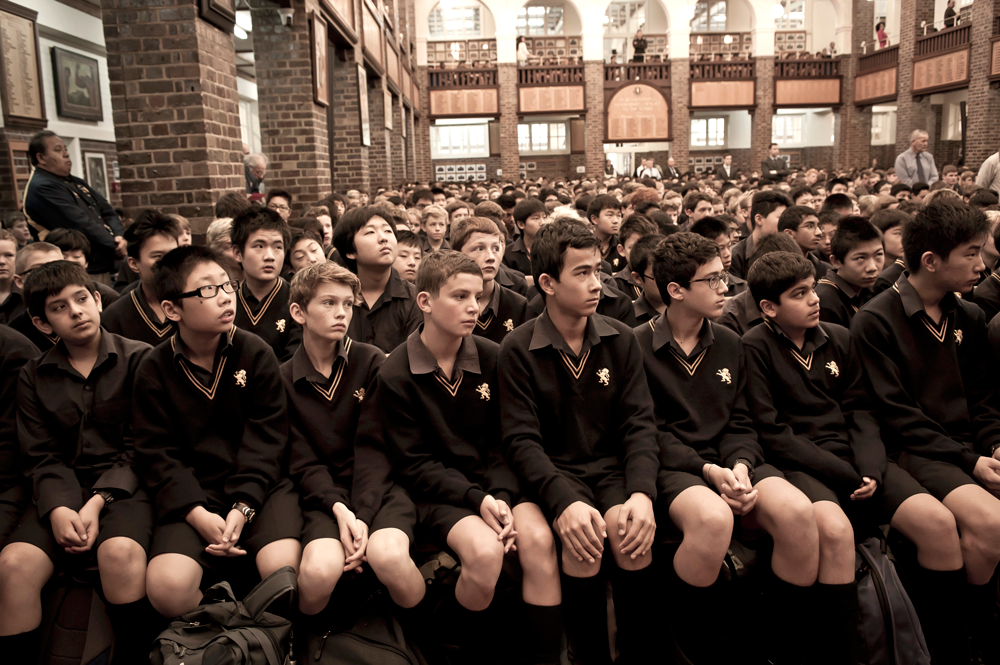
In the art of teaching — pedagogy, they call it in the trade — there seems to be a constant stream of ideas on how to do things differently or better. Hattie’s research tested the impact of 200 of them and found most will work to some degree.
“Ninety-five to 98 per cent of things we do in the name of enhancing achievement does enhance achievement. All you need to enhance achievement is a pulse.” What makes the biggest difference is the expertise of the teachers — “teachers who work together collaboratively to understand their impact”.
The four schools we looked at all use student feedback, usually in the form of written evaluations, to direct teaching. At Grammar, teachers use them in performance appraisals to show how they’ve changed their techniques when something didn’t work. Asked how many teachers he’s sacked for poor performance, O’Connor won’t say. “That’s an unfair question. But I will say that while we have high standards for the boys, we have exactly the same for the teachers.”
Sandy Pasley says once teachers hit “adequate” salaries, higher pay doesn’t sustain motivation and performance.
He acknowledges, though, that recruitment of high-quality teachers is a constant problem, partly caused by variations in quality at the country’s 27 teacher-training institutions. “We’re not attracting the very best students out of our high schools to go into teaching because the salaries aren’t high enough.”
But Pasley says once teachers hit “adequate” salaries, higher pay doesn’t sustain motivation and performance long term. At Baradene, the emphasis has been on giving high-performing teachers carrots in the form of overseas trips for conferences or school programmes, and the opportunity to do university courses or present papers.
Baradene history teacher Brent Coutts is just back from a sponsored trip to Chauny in France to visit a school that’s twinned with the college in a World War I “shared histories” project.
Exchanges and overseas trips are a regular feature of school life for the students who can afford them. In the Easter holidays this year, language students went to Guatemala and Mexico and the school orchestra went to Eastern Europe. This year, Baradene also became a Microsoft IT academy school, offering Microsoft qualifications, and sent three teachers to Barcelona for a week-long conference.
At St Cuthbert’s, Reid says that while she’s in awe of her teaching staff, none of them seems to want “rock star” teachers to be paid more. “They’re recognised in all sorts of ways from a box of chocolates through to being nominated for external awards. Our goal is to reward all of them.” Any under-performers are teamed with a mentor teacher and shown how the best teachers in other classrooms and other schools are working. “They will have a lot of intensive work,” says Reid.
Mt Roskill principal Greg Watson says that of 140 teachers, only three or four a year are identified as needing help with their performance; over the past five years, two or three have left after formal competency reviews began.
A commonality in these schools is the low churn rate of teachers, of less than 10 per cent a year. At Grammar, it’s around three per cent — more than 20 current masters have been at the school for at least 25 years — and at Roskill, more than half have been there longer than 10 years.
All these schools regularly, both formally and informally, peer-review their teachers, both in their classrooms, with “walk throughs” by heads of department and the principals, and in professional learning groups.
St Cuthbert’s has a director of professional learning and teachers are regularly showcasing to others innovations they’ve successfully tried. But Reid says it’s not generally the “rock stars” who run them. “If you put too many of them up, people say, ‘Oh well, they can do it but I couldn’t.’”
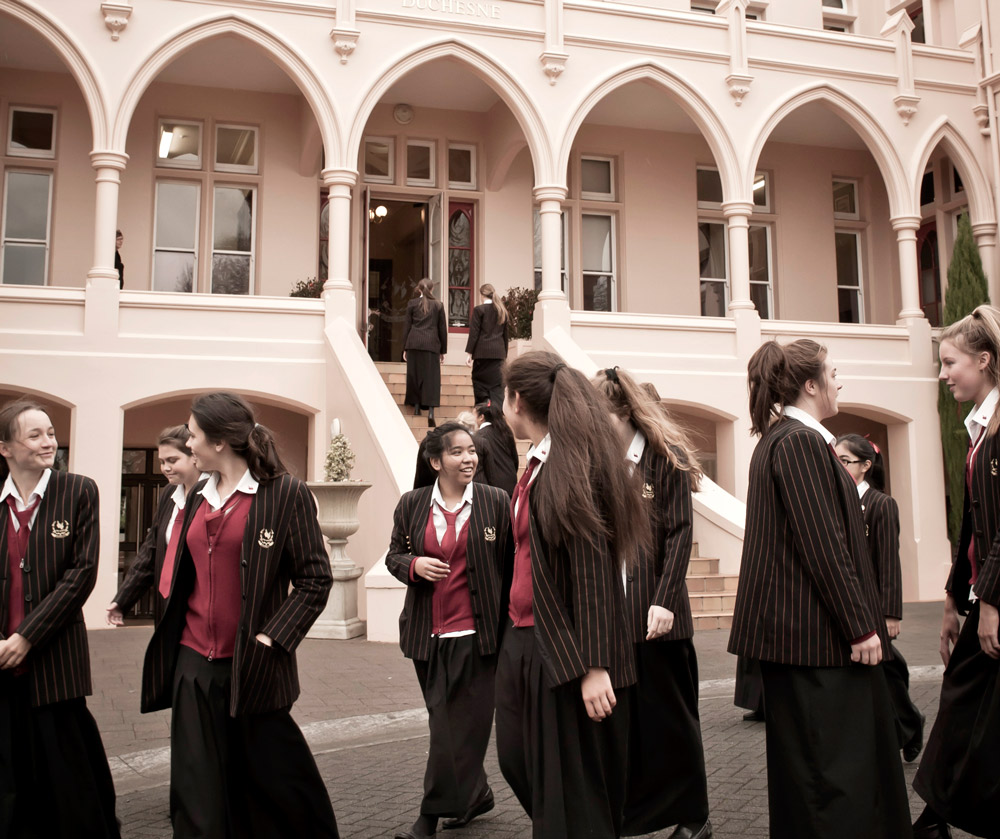
In the past three years, Baradene has introduced “academic signposting” where, every five weeks (about twice a term), teachers flag potential problems with up to five students in each class and, if there are two or three concerns — it may be an assignment or homework not completed, attendance issues, or other signs a girl is struggling with a subject — letters go home to parents. “It’s a heads-up to families so they’re not getting big surprises at the end of term,” says Pasley.
The school also rigorously analyses early predictors of academic success from mid-year testing, which starts in Year 7 — two years before the girls get to high-school level. The mid-year tests are based on cognitive ability, rather than a grasp of the curriculum. Pre-secondary results are also key at Roskill, where many students are on the same campus from the start of their school life, at Mt Roskill Primary and Intermediate schools.
Mt Roskill’s students are often under-achieving when they enter the school — commonly the result of having English as a second language — but more than 80 per cent of its students leave with NCEA level 2, well ahead of the national average.
Peer mentors work with younger charges three times a week on plastic tables in the school library and three years ago, the school introduced academic coaching for each of its 400-odd Year 11 pupils. All the teachers are involved, and have three or four students each to mentor. It’s a learning scaffold, says Watson, aimed at guiding pupils through NCEA.
Roskill has long boxed above its decile in its results with more than nine per cent of its Year 13 students achieving scholarships — a rate more common among decile 9 and 10 schools. And like Auckland Grammar, Roskill celebrates its successes at assembly, but without the formality. There are just two student honours boards here, among the flags of the 70 nationalities on the school roll, and they seem dull, neglected, stencilled things compared with the glow of Auckland Grammar’s.
Auckland Grammar old boys include brains such as Sir Peter Gluckman, Tom Schnackenberg and Sir Graham “Mont” Liggins. Mt Roskill has self-made multimillionaires Sir Owen Glenn and Graeme Hart. Both schools lay claim to Russell Crowe. The day Metro visits, the speaker is one of the school’s brightest young leaders — prefect, mediator and 1st XI hockey player Junior Kasiano — who talks of the pressures of society’s labels. He greets the school with a big, “Hey guys!” Something you’d never hear from the stage at Auckland Grammar, where it’s all sirs and surnames.
Glenn recognised and exploited this informality when he returned to the school assembly three years ago as a fêted old boy. He talked about how he learned to lose graciously playing rugby against the rich boys from the big schools like Auckland Grammar and King’s. How they always gave the Roskill boys a hiding. “Bastards,” he said.
As I wrote then, he lobbed the word quite intentionally, too — this was an audience that identified with someone who could be… well, naughty. They nearly wet their pants. And they didn’t take their eyes off him for the next 20 minutes.
Likewise, Kasiano’s talk today is perfectly pitched, urging his peers to “hold true to our own values” rather than be swayed by the shallow pressures of advertising and gossip. “They say if you hang out with boys you’re a slut; if you hang out with girls you’re skuxx or gay.”
There are hijabs and turbans here, and a burly senior student sports a bright orange fabric daffodil on his school bucket hat.
The school hall isn’t big enough for one assembly, so half the school attends at a time. There are hijabs and turbans here, and a burly senior student sports a bright orange fabric daffodil on his school bucket hat. Yes, uniforms are still important, to a point, but they’re not deal breakers. “We’ve moved on from those days,” says Hoogendoorn. “The focus is on achievement, and kids being in class, and our results speak for themselves.”
The school employs four trained counsellors and all Year 9 students fill out extensive personal questionnaires trying to identify “loss, change and grief” issues. They also get a one-on-one interview with a nurse to identify problems such as abuse.
Teacher and dean John Leen identifies the elephant in the room. “There’s a disparity in resources in the homes that Auckland Grammar students come from compared to our school. I’d rather see a student here for 25 periods a week in Chucks than scared to enter school because he’s afraid of being sent home.”
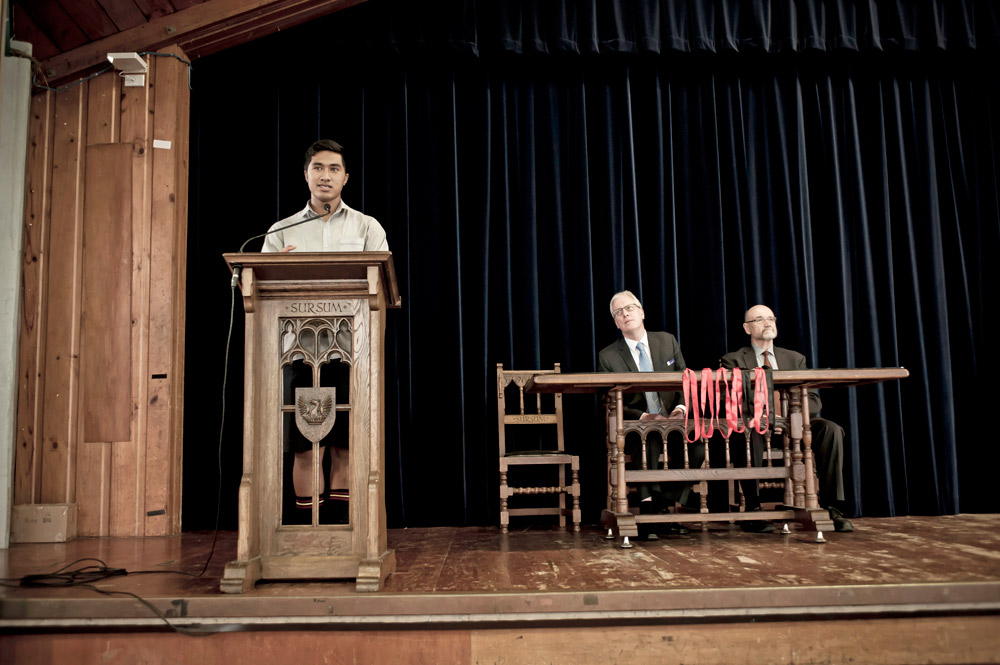
Monday, June 16, 8.50am. In the pre-assembly hubbub at Auckland Grammar, all eyes are on members of the victorious 1st XV, who downed King’s on Saturday 27-15: the first time in 20 years either school has won three clashes in a row. There are few handshakes, compared to the much more common slap, twist, clench, pull and knuckle tap.
On the long bell at 9am sharp, the hall falls suddenly and completely silent as O’Connor, in flowing black gown, ascends the stage and the boys stand.
After the Bible reading and prayer, it’s on to the sports results, but the headmaster saves the best for last as he reads premier match reports from badminton, squash, basketball and football before the rugby. Team captain Rob Harris crosses the stage to receive the Cooper-Greenbank Trophy — named after former headmasters of each school. He raises the cup — the crescendo of the applause rises, distinctly and briefly, on cue.
It is only then that O’Connor outlines the importance of Saturday’s win. “We’re there to try to win a game of rugby but it provides us with a platform to share something together as a school — that school pride, that school spirit, and that was done in outstanding fashion. It endorsed the Grammar Way.”
In 2019, he says, the school will host King’s for the game in Grammar’s 150th year. “You should make your way back here as old boys to celebrate what you’re part of.”
The team, and the boys, will be different then, but Grammar’s heart, the assembly, will beat in exactly the same way.


